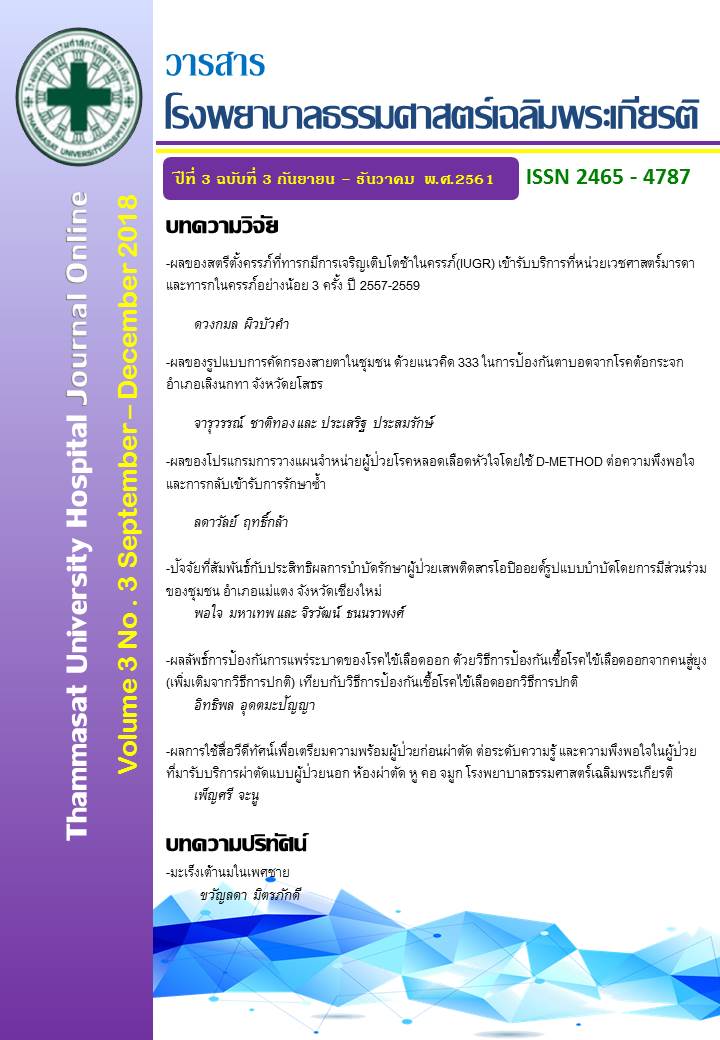Factors that affect treatment outcome of opioid use disorder with community participation in Maeteang ,Chiangmai province
Keywords:
Effective treatment, Opioid use disorder patients, Community treatmentAbstract
Background : Opioid use disorder is a complex public health problem in the North of Thailand that leads to many health concerns.
Objective: This study was aimed to study the effectiveness of opioid use disorder treatment with community participation and factors that affect treatment outcome.
Material and methods :The sample consisted of 144 patients who volunteered to participate in Royal Project Extended in Tambom Kuet-chang and Tambon Ban-chang, Maeteang District,Chiangmai Province between 1st October 2014 to 31th December 2017. Data was analyzed using descriptive statistics and Chi-square.
Result : The majority of the participants were male (88.55%). Most patients age between 31-60 years old, used opium by smoking 1-5 years about 4-8 grams per day before treatment. Eighteen patients could stop using opium for more than one year (12.5 %) while 64 patients could stop using opium less than one year (44.44%). In the group of patients who could stop using opium more than one year, mean dose of methadone in detoxification was 20.50 mg/day, mean dose of methadone in rehabilitation was 30.94 mg/day. Their mean of participated health education programs was 19 times. Mean of duration in treatment was 34.16 months. Duration in treatment was significantly associated with treatment outcome (p=0.002).
Conclusion: In organizing activities to treat opioid use disorder patients in community, the patients should be maintained in the treatment program as long as possible for better efficacy because methadone alone is not enough for opioid discontinuation they can for effectiveness.
References
United Nations Office on Drugs and Crime.World drug report 2017 [internet]. [cited 13 September 2017]. Available from: https://www.unodc.org.
Jordan AE,Blackburn NA, Des Jarlais DC, Hagan H. Past year prevalence of prescription opioid misuse among those 11 to 30 years of age in United Stages: A systematic review and meta analysis.J Subst Abuse Treat 2017; 77:31-37.
วิภา ภาวนาภรณ์. สถานการณ์แนวโน้มระบาดวิทยาและการลดอันตรายด้วยการใช้เมทาโดน. ใน:วิโรจน์ วีรชัย, ปัญจรัตน์ ศรีสว่าง, ธญรช ทิพยวงษ์ บรรณาธิการ.หลักสูตรการบริการเมทาโดนระยะยาว.พิมพ์ครั้งที่ 1.กรุงเทพมหานคร:โรงพิมพ์แห่งจุฬาลงกรณ์มหาวิทยาลัย:2553 หน้า 2.
ฐานข้อมูลจากงานยาเสพติด กลุ่มงานควบคุมโรค สำนักงานสาธารณสุขจังหวัดเชียงใหม่ 2561.
พิฐชญาณ์ สุขสาครธนาวัฒน์. การบำบัดผู้ป่วยเสพติดฝิ่นและเฮโรอีนด้วยเมทาโดนระยะยาว.HARM คลินิกลดอันตราย โรงพยาบาลธัญญารักษ์ขอนแก่น. 2559 [อินเตอร์เน็ต] [เข้าถึงเมื่อ 10 มกราคม 2561]. เข้าถึงได้จาก: https://www.tyrkk.go.th/web/page/19.
วีรวัต อุครานันท.Methadone Maintenance Therapy in Opioid Dependence : Review Literature.วารสารกรมการแพทย์ 2560; 42:116-21.
Kevin P. Hill, Lindsay S. Rice,Hilary S. Connery,Roger D. Weiss.Diagnosing and treating opioid dependence. The Journal of Family Practice 2012; 10:588-96.
Gavin Bart. Maintenance Medication for Opiate Addiction: The Foundation of Recovery. J Addict Dis 2012; 31:207-25.
Susan M. Stine, Thomas R. Kosten. Methadone Dose in the Treatment of Opiate Dependence. Medscape Psychiatry &. Mental Health eJournal 1997;2(6).
Donny EC, Brasser SM, Bigelow GE, Stitzer ML, Walsh SL. Methadone doses of 100 mg or greater are more effective than lower doses at suppressing heroin self-administration in opioid-dependent volunteers. Addiction 2005; 100(10):1496-509.
Magdalena Nalaskowska, Lidia Cierpiałkowska. Social and psychological functioning of opiate dependent patients in methadone maintenance treatment – longitudinal research report. Alcoholism and Drug Addiction 2014; 27:237–54.
Marc A. Schuckit. Treatment of Opioid-Use Disorders. N Engl J Med 2016; 375:357-68.
วีระพันธ์ งามมี.การให้บริการสารทดแทนเมทาโดนระยะยาวในชุมชนรูปธรรมของการบำบัดรักษาผู้เสพติดฝิ่นและสารอนุพันธ์ฝิ่นอย่างมีประสิทธิภาพและยั่งยืนหมู่บ้านสันติคีรี ตำบลแม่สลองนอก อำเภอแม่ฟ้าหลวง จังหวัดเชียงราย . กรุงเทพมหานคร: มูลนิธิพีเอสไอ (ประเทศไทย); 2558.
Steven Simoens, Catriona Matheson, Christine Bond, Karen Inkster, and Anne Ludbrook.The effectiveness of community maintenance with methadone or buprenorphine for treating opiate dependence. British Journal of General Practice 2005; 55:139–46.
Dugosh K, Abraham A, Seymour B, McLoyd K, Chalk M, Festinger D. A Systematic Review on the Use of Psychosocial Interventions in Conjunction With Medications for the Treatment of Opioid Addiction. Journal of Addiction Medicine 2016 ; 10(2):93–103.
National Institute on Drug Abuse (NIDA). Principles of Drug Addiction Treatment: A Research-Based Guide (Third Edition) [internet]. 2018 [cited 10 April 2018]. Available from: https://www.drugabuse.gov/publications/principles-drug-addiction-treatment-research-based-guide-third-edition/principles-effective-treatment.
National Institute on Drug Abuse (NIDA).Understanding Drug Abuse and Addiction: What Science Says [internet]. 2016 [cited 10 Mar 2018]. Available from: https://www.drugabuse.gov/publications/teaching-packets/understanding-drug-abuse-addiction/section-iii/6-duration-treatment.



